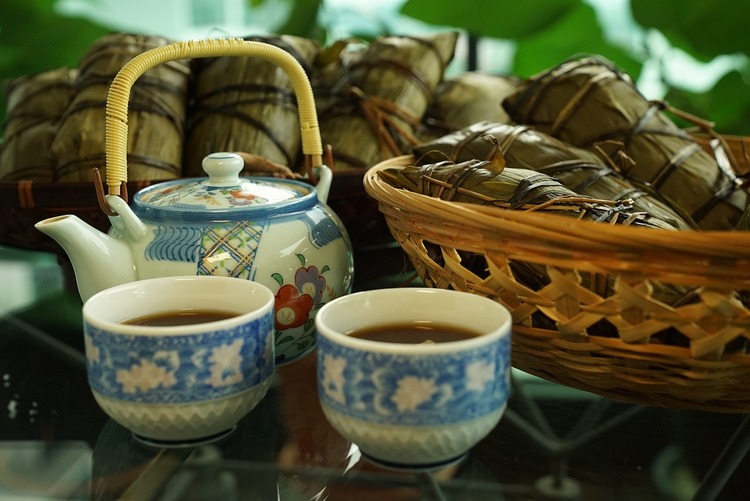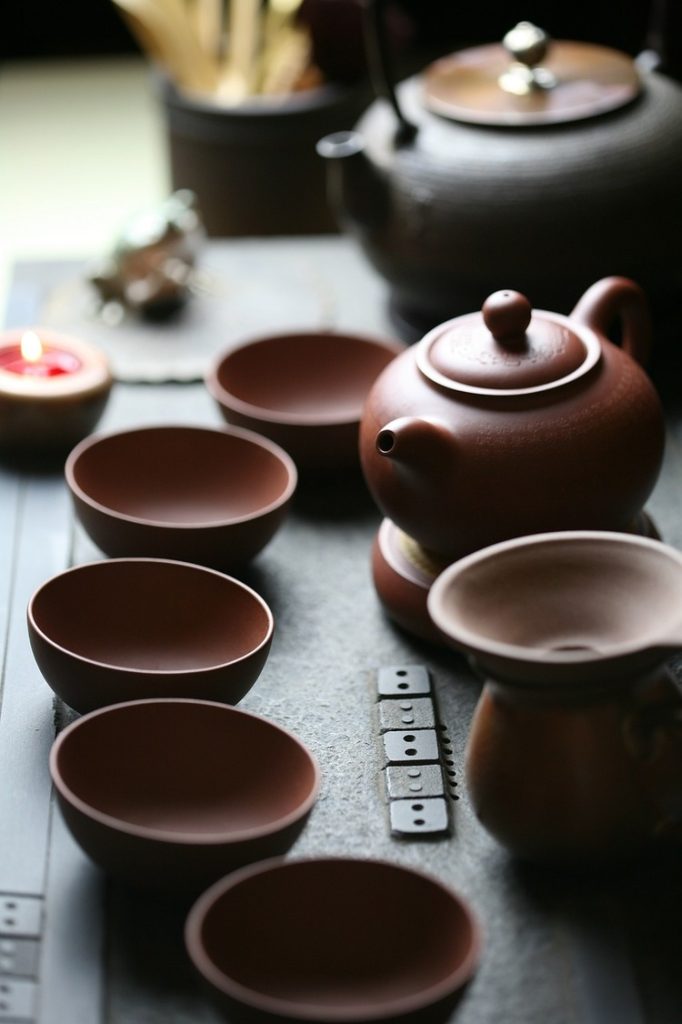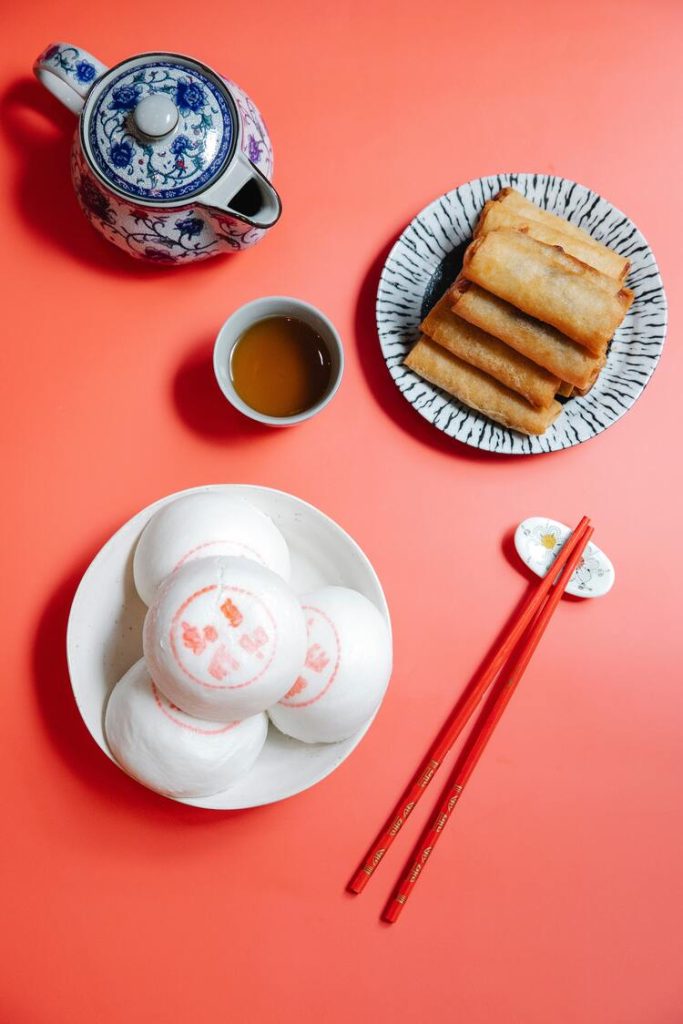Shui Jin Gui tea hails from the Wuyi Mountains in China’s Fujian Province, an area renowned for its sophisticated oolongs (partially fermented teas). Teas from this region are known as Wuyi teas, yancha teas, or rock teas due to the characteristics of the terrain where tea bushes grow.
Shui Jin Gui has a rich, full-bodied taste with notes of honey, caramel, and roasted nuts.
This article explores this delicious tea, starting with its history and moving to its characteristics, production process, variations, and more.
Please note: This article contains affiliate links, meaning I may earn a commission if you make a purchase by clicking a link. Of course, this comes at no extra cost to you and helps me keep offering readers solid information.

Origins and History
Fujian Province
The Fujian Province in China is known for producing some of the finest teas in the world, including the famous Shui Jin Gui tea. Fujian Province is located in the southeast of China and is home to some of the most beautiful tea gardens in the country. The region has a long history of tea production, dating back to the Tang Dynasty (618-907 AD).
Wuyi Tea
Within Fujian Province, the Wuyi Mountains region is particularly famous for its tea production. This area is known for its unique rocky terrain, which provides the perfect growing conditions for tea plants. The region’s high altitude, misty climate, and mineral-rich soil all contribute to the unique flavor and aroma of the tea.
Because of this, teas grown and processed in the region are called after the area of origin or terrain characteristic (Yan Cha, or Rock Teas).
There are four prominent tea cultivars in the area: Shui Jin Gui, Da Hong Pao, Tie Luo Han, and Bai Ji Guan. Other cultivars are grown in the area. Remember, a cultivar is a variety created to yield specific characteristics.
Production Process
Harvest
As mentioned in the previous paragraph, Shui Jin Gui tea is made from the leaves of a cultivar native to the Wuyi Mountains. The bushes have been propagated through cuttings for decades.
The leaves are hand-picked by experienced tea farmers during the spring and autumn harvest seasons. Only the top two leaves and a bud are plucked from each branch to ensure the highest quality of tea.
Roasting
Like other oolong teas, leaves are withered, cooled, rolled, oxidized (medium level), and fixated after the harvest.
Each of these steps requires craft. After all, the process of producing oolong teas is complex. However, roasting is crucial in producing high-quality Shui Jin Gui tea.
The roasting vessel, often a large iron or clay pot, is preheated to ensure a consistent and controlled heat source. This helps create the optimal conditions for roasting the tea leaves.
The processed tea leaves are carefully placed into the roasting vessel. The leaves are spread out in a thin layer to allow for even heat distribution and consistent roasting.
The tea leaves are subjected to a controlled heat source, typically generated by burning the charcoal. The tea master closely monitors the roasting process, adjusting the heat intensity and duration based on their expertise and desired outcome.
The leaves are periodically flipped or shifted within the vessel during roasting. This ensures that the leaves are exposed to the heat evenly and prevents any potential burning or uneven roasting.
Shui Jin Gui tea leaves are often roasted multiple times over several hours or even days. The roasting may start at a relatively lower temperature to gradually infuse the tea leaves with the charcoal’s flavor and aroma. As the process progresses, the temperature may be increased to deepen the roasted notes.
Once the desired roasting level is achieved, the tea leaves are carefully removed from the roasting vessel and allowed to cool down.
The leaves are then sorted according to size and quality and packaged for distribution.

Characteristics of Shui Jin Gui Tea
Golden Water Turtle
In English, Shui Jin Gui translates to “Golden Water Turtle” or “Golden Marine Turtle.” It is named after a mythical creature believed to bring good luck and prosperity.
Part of a legend involving the tea states the leaves absorbed the essence of the turtles, giving it the flavor and aroma that has increased its reputation.
Leaves
Shui Jin Gui tea leaves are medium-sized and have a dark green color with a golden tint. The leaves are tightly rolled and have a slightly twisted appearance. When brewed, the leaves unfurl and release a fragrant aroma.
Flavor Profile
As for a flavor profile, here is what you can expect from the tea:
- Rich Roasted Notes: The tea has a prominent roasted character, contributing to its depth and complexity. The roasting process imparts flavors reminiscent of toasted nuts, baked bread, or caramelized sugar.
- Sweet Honey or Caramel: A natural sweetness, like honey or caramel, adds a pleasant richness to the tea, balancing out the roasted flavors and offering a smooth, luscious taste on the palate.
- Orchid or Floral Undertones: This tea’s subtle but notable aspect is its floral undertones. Hints of orchids impart a delicate and fragrant essence that adds an elegant touch to the overall flavor.
- Fruitiness: A touch of fruity notes, although they are typically more subdued than the roasted and floral aspects. Some varieties of Shui Jin Gui may have hints of ripe plums, dried fruit, or even a gentle citrus zest, contributing to a subtle complexity and layering of flavors.
- Mineral Earthiness: Another characteristic is a distinct mineral quality, often described as a “rocky” or “mineral” taste.
Aroma
The aroma is fruity and refreshing. The fruity aroma is reminiscent of citrus fruits. What is more, the aroma is also slightly sweet and complements the tea’s flavor profile.
Varieties and Comparisons
While Shui Jin Gui is primarily recognized as a single cultivar, variations and grades within this cultivar offer different characteristics. Here are some varieties:
Traditional
This variety represents the classic and authentic expression of Shui Jin Gui tea. It is typically produced using traditional processing methods, including slow roasting over charcoal. The leaves are twisted and dark in color, resulting in a tea with a bold and mellow flavor profile.
Modern
As tea production methods evolve, modern variations of Shui Jin Gui have emerged. These teas may undergo different processing techniques, including lighter roasting or alternative firing methods. Modern teas may showcase a brighter, fresher flavor profile, with more pronounced floral or fruity notes alongside the characteristic roasted undertones.
High-Grade
Within the Shui Jin Gui cultivar, there are higher grades of tea that are highly sought after by tea connoisseurs. These teas are crafted from select leaves and processed with great care. High-grade teas often exhibit a more complex and refined flavor profile, balanced sweetness, floral or fruity notes, and a lingering mineral or roasted character.
Aged
Just like other oolong teas, Shui Jin Gui can be aged to develop unique characteristics. Aged teas undergo natural oxidation and fermentation over time, resulting in a distinct flavor transformation. These teas may develop deeper flavors, with earthy, woody, and sometimes even medicinal notes. Tea enthusiasts cherish aged teas for their complexity and the depth of their flavors.
It is worth noting that the taste and characteristics of this tea can vary depending on factors such as terroir, specific processing techniques, and the expertise of the tea master. Each variety offers a different tea-drinking experience, allowing enthusiasts to explore the nuances and diversity within this esteemed Wuyi tea cultivar.

Brewing Shui Jin Gui Tea
Gong Fu Brewing Method
If you want to enjoy the full flavor of Tie Guan Yin, then the Gong Fu brewing method is recommended. This method involves using a small teapot (Yixing clay teapot) and brewing the tea in multiple short infusions. This brewing method ensures the best taste. Here’s how you can do it:
- Preheat your teapot and cups by rinsing them with hot water.
- Add the tea leaves to the teapot. The amount of tea leaves will depend on the size of your teapot, but a general guideline is 1-2 teaspoons of leaves for every 6-8 ounces of water.
- Pour hot water over the tea leaves and immediately pour it out. This helps to rinse the tea leaves and awaken their flavor.
- Refill the teapot with hot water and steep it for about 20-30 seconds.
- Pour the tea into your cups and enjoy the fragrant aroma and delicate taste.
- Repeat steps 4 and 5 for multiple infusions, gradually increasing the steeping time with each infusion. You can increase each infusion’s steeping time by 10 to 20 seconds.
Please pay attention to the last step. You can (and should) infuse your oolong tea multiple times. Please make the most out of it!
Gaiwan Brewing Method
You can use a gaiwan to brew tea as well. A gaiwan is a traditional Chinese tea vessel that allows you to control your tea’s temperature and steeping time. Here’s how to use it:
- Warm the gaiwan and tea cups with hot water,
- Add the tea leaves to the gaiwan. Use 1-2 teaspoons of leaves for every 6-8 ounces of water.
- For heavily roasted oolongs, pour hot water over the tea leaves and immediately pour it out. This helps to rinse the tea leaves and awaken their flavor.
- Slowly pour water over the leaves till the rim of the gaiwan.
- Add the lid and steep for 20-30 seconds.
- Pour the tea into teacups. While doing this, hold the gaiwan with your thumb and middle finger. Secure the lid with the index finger.
- Repeat the process with multiple infusions.
Western Style Brewing
If you prefer to brew tea using Western methods, start by heating the water. Put one teaspoon of tea leaves into a tea infuser or strainer and place it in a cup. Pour the hot water over the leaves and let it steep for about 3-4 minutes. Remove the infuser or strainer, and enjoy your tea.
Ideal Water Temperature
The water temperature plays a crucial role in brewing this tea. If the water is too hot, it can burn the delicate tea leaves and ruin the flavor. On the other hand, if the water is too cold, it may not extract the full flavor of the tea leaves. Here’s the ideal water temperature for brewing this particular tea:
- Bring fresh, cold water to a boil.
- Let it cool down for 2-3 minutes until the water temperature reaches around 190-200°F (88-93°C).
- Pour the hot water over the tea leaves and let it steep for the desired time.
Remember to use fresh, cold water that is free of any impurities. Avoid tap water if possible, as it may contain chlorine or other chemicals that can affect the taste of your tea.
Buying Recommendations
As with other teas, you should keep a few things in mind to ensure you get the best product for your money.
Make sure you read the label of the product you intend to buy. It should clearly state the place of origin of the tea leaves. It is better to choose teas with information about the particular cultivar/variations versus a tea labeled generically as oolong.
Look for entire tea leaves. Avoid leaves that are broken or have a lot of stems or twigs mixed in. Also, tea leaves picked from older plants tend to have a richer, more complex flavor.
I recommend visiting a local tea provider or specialist. If, for some reason, you cannot do this, here are some recommendations from an online retailer:
Shui Jin Gui Golden Water Turtle Fujian Rock Tea

The Tea Farm – Shui Jin Gui Oolong Tea

Frequently Asked Questions
What are the health benefits of Shui Jin Gui tea?
Shui Jin Gui tea is known for its health benefits, including aiding digestion, reducing inflammation, and promoting weight loss. It is also believed to help lower cholesterol levels, improve heart health, and boost the immune system.
How do you prepare Shui Jin Gui tea?
To prepare Shui Jin Gui tea, boil water and let it cool to around 90°C. Then, add 3-5 grams of tea leaves to a teapot and pour the hot water over them. Let it steep for 30-60 seconds, pour the tea into cups and enjoy.
What is the taste profile of Shui Jin Gui tea?
Shui Jin Gui tea has a unique taste profile, with a rich and robust flavor that is sweet and slightly floral. It has a smooth and silky texture and a long-lasting aftertaste that lingers in the mouth.
What is the difference between Shui Jin Gui and other Wuyi rock teas?
Shui Jin Gui tea is one of the most popular Wuyi rock teas, known for its distinct flavor and aroma. It is different from other Wuyi rock teas in that it has a slightly sweeter and floral taste, smoother texture, and a more delicate aroma.
What are the origins of Shui Jin Gui tea?
Shui Jin Gui tea is a type of Wuyi rock tea that originated in the Wuyi Mountains of Fujian province in China. It is named after the golden water turtle, believed to bring good luck and fortune.
What are some recommended food pairings with Shui Jin Gui tea?
Shui Jin Gui tea pairs well with various foods, including seafood, chicken, and vegetables. It is also a great complement to sweet and savory snacks, such as fruit, nuts, and cheese.

I hope you enjoyed the article and learned something new. See you next time!
Have you tried this tea?